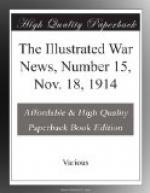At midnight on November 6—seven hours before the German garrison of Tsing-tau surrendered, the central fort was captured by the Japanese, who took 200 prisoners. The Germans had made great efforts to repair their batteries, but the shell-fire from the Japanese guns was too heavy. After the central fort had fallen the Japanese captured at the point of the bayonet other forts and the strong field-works connecting them. It was stated that some 2300 German prisoners were taken when Tsing-tau surrendered. The German garrison, it is said, included four companies of seaman gunners, an equal force of Marines, some cavalry and field gunners, and a company of sappers. Probably the garrison increased after the war began, as Germans from all parts of China gathered at Tsing-tau for protection.
_______________________________________________________
___________________ 32—The illustrated war news, Nov. 18, 1914.
[Illustration: A zeppelin brought down: Remains of one of the much-discussed German air-ships hit and destroyed near Belfort.]
Considering the amount of discussion—not to say, in some quarters, apprehension—to which the Zeppelins have given rise, singularly little has been heard of them so far during the war, and, apart from the Antwerp exploits, they have done practically no damage. On the other hand, several have been destroyed: the number has been variously estimated from two to six. One, said to be the “LZ10,” was brought down in October at Grandvilliers, ten miles from Belfort. Our photographs show: (1) debris of the shattered framework; and (2) wreckage of the cars. Another Zeppelin was destroyed in October by the fire of Russian batteries near Warsaw, and its broken remains were taken to Petrograd to be examined. The British air-raid on Duesseldorf also accounted for one or possibly two.
_______________________________________________________
___________________ The illustrated war news, Nov. 18, 1914—33
[Illustration: British soldiers as cave-dwellers: The underground, shell-proof quarters of “A certain Highland regiment” At the front.]
The ground occupied by the British troops on the banks of the Aisne consisted, in many places, of steep hill-sides or cliffs penetrated like a rabbit-warren with the workings of old stone-quarries. The officer who sends us the above interesting sketch writes: “This cave afforded shelter both from rain and ‘Jack Johnsons’ for several weeks to ——, a certain Highland regiment. The cave consisted of three long passages capable of holding a whole battalion. It had two entrances, one of which is shown in the sketch. It was dark and dirty, but with plenty of straw on the ground it made a fairly comfortable refuge. The sketch shows the part of the cave occupied by the officers and headquarters.”—[Facsimile Sketch by a British Officer.]




